Plane evaluation – Lightweight thin-ironed planes really work…
…and they work exceptionally well.
The title says it. Buy #4s and 4 1/2s, 5s and 5 1/2s of the old style Stanleys and Records with impunity. Don’t retrofit with thick irons or special cap irons; fettle, flatten and sharpen well and your cheaper plane will work just fine. Forget micro bevels and go for convex cambers and your planes will be easy to sharpen, lighter to use and they will not chatter.
Wow! How is that for going against the flow of popular opinion and the media. Well, it’s all true.
Today I used two #4 Stanley planes to flatten and true 6 pieces of oak ranging in size between 1″ thick to 4-8″ wide and 37″ long. The oak had been initially bandsaw cut by the miller and had undulated surfaces and no straight edges or faces. I used other planes but relied on the #4 to test out my feelings that we have dismissed a valuable and well-proven asset in out arsenal of planes. So cheap are these planes secondhand or new that you cannot afford to dismiss owning two or three of them in your plane set.
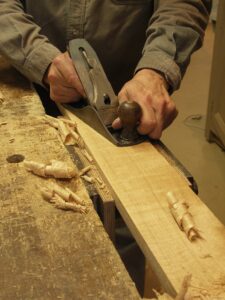
I opened the throat for the initial shaving. To get down through the rougher bandsaw cuts…
…and closed the throat for refining cuts and smoothness.
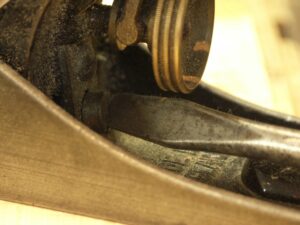
Now this is what I non-scientifically feel in what I did. The #4 was an ordinary #4 fattened and well sharpened by my apprentice, John. I found it light to hand yet in no way wimpy. It never balked at the workload ahead of the cutting iron and surfaced the grain smartly. When the grain was wild and unobliging I simply planed across the grain and resolved the rebellion with ease.
The key ingredient in all of this is sharpness and keeping sharpness by being willing to sharpen when needed. In saying that, I surfaced planed 20 square feet of oak, knots, reverse and wiry grain and all, without the need for a second sharpening and the plane was still sharp when done.
Tomorrow I am weighing some planes I use and used for this testing so you can compare.
Here is another clue for tomorrow’s blog. You can adjust the frog on a Bailey frog more easily than you can a Bed Rock. I did that with mine in these planing operations and experienced no shudder, judder, jerking or shirking and definitely no “chatter“.
You must remember that heavy planes are not self motivated. Every ounce of bulk and weight touted as advantageous must be countered by the need for additional energy to shove it back and forth. Newton’s law of equal and opposite forces prevails. Don’t always accept what tool salesmen and tool makers tell you, and tool reviews can scarcely consider themselves impartial if they are selling advertising space. Simply be cautious and if in doubt I will open it up here for balanced discussion.
More about the reality of how frogs work tomorrow.


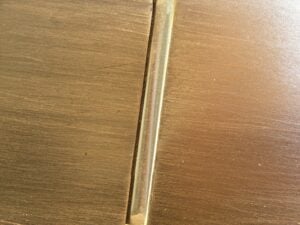
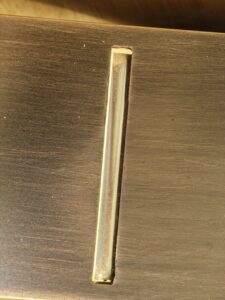
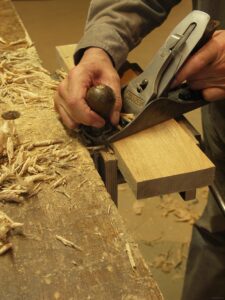
Ah! It’s so refreshing to hear that you don’t need to buy super-expensive hand tools to do wood working. I have always balked at paying many hundreds of dollars for the planes that everybody else seems to be pushing around. I have two old planes which I got for $20 each and they take clean thin shavings, with sharp blades being the key. Planes really cant be that complicated. IMHO, a sharp blade held at the right angle is all that is.
I am really glad to see you say this. I am pretty sick of the gear-mania that seems to have afflicted the humanity 🙂
Yes, i want people to be well down the road and be able to choose from their working knowledge and not the working salesmen that hide behind making thin shavings only.
More to come yet.
best regards,
paul
I assume you leave the frog screws loose enough for the adjusting screw to move the frog – correct?
Well, when I was a lad no one I ever worked with or under took the plane apart to get to the setscrews so I have always set the screws with moderate tightness and the frog adjusts as needed quite readily. The only thing is that without removing the lever cap and cutting iron assembly you have no guarantee that the frog is aligned perfectly to the throat, but I have never once had that as an issue in 45 years.
I have just posted something that I think explains some of why I do what I do. Letters like your inspire me. We are looking for sanity, but often in the wrong places.
Paul have you worked with good Japanese planes? I thought I had worked out all the theory there was on axes and hewing from European technology then went Japanese and here was a completely different system which also worked and changed many of my theories.
I have used them and there are several takes on sharpening I feel have radically changed the way people, almost everyone, sharpens. Someone else has just related a question to me on sharpening some things relating to plane irons and in my book I have countered the type of sharpening people are involved in by looking back to tradition. I am planning to make some radical suggestions by reinstating some traditions that worked for two hundred and more years this week, but I need to prepare for it.
Paul,
I wholeheartedly agree regarding your recent posts on the Bailey design and thin blades. I have yet to experience chatter and I only have Stanley and Record stock blades and chipbreakers and none of my planes are bedrocks. And don’t tell anyone, but the stock Record Tungsten Vanadium alloy blades are as good or better than any of the current crop of cryogenic A2 space shuttle steel boutique blades being peddled. I also love that I can have a set of 3 different blades that I can use in the same plane for different applications. This is a tremendous benefit for those of us that want to work wood on a strict budget.
Also, I have very much enjoyed the hope chest series as well as your inspirational and philosophical posts regarding the craft.
Jeff
Thank you for your agreement and encouragement. We help one another and others long the way don’t we?